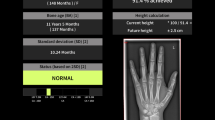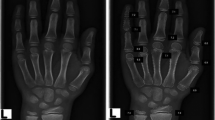Abstract
Greulich and Pyle (GP) is one of the most common methods to determine bone age from hand radiographs. In recent years, new methods were developed to increase the efficiency in bone age analysis like the shorthand bone age (SBA) and automated artificial intelligence algorithms.
Objective
The aim of this study is to evaluate the accuracy and reliability of these two methods and examine if the reduction in analysis time compromises their efficacy.
Methods
Two hundred thirteen males and 213 females had their bone age determined by two separate raters using the SBA and GP methods. Three weeks later, the two raters repeated the analysis of the radiographs. The raters timed themselves using an online stopwatch. De-identified radiographs were securely uploaded to an automated algorithm developed by a group of radiologists in Toronto. The gold standard was determined to be the radiology report attached to each radiograph, written by experienced radiologists using GP.
Results
Intraclass correlation between each method and the gold standard fell within the range of 0.8–0.9, highlighting significant agreement. Most of the comparisons showed a statistically significant difference between the new methods and the gold standard; however, it may not be clinically significant as it ranges between 0.25 and 0.5 years. A bone age is considered clinically abnormal if it falls outside 2 standard deviations of the chronological age; standard deviations are calculated and provided in GP atlas.
Conclusion
The shorthand bone age method and the automated algorithm produced values that are in agreement with the gold standard while reducing analysis time.


Similar content being viewed by others
References
Heyworth BE, Osei DA, Fabricant PD, et al. The shorthand bone age assessment: a simpler alternative to current methods. J Pediatr Orthop. 2013;33(5):569–74. https://doi.org/10.1097/BPO.0b013e318293e5f2.
Bass S, Pearce G, Bradney M, et al. Exercise before puberty may confer residual benefits in bone density in adulthood: studies in active prepubertal and retired female gymnasts. J Bone Miner Res. 1998;13:500–7.
Martin DD, Wit JM, Hochberg Z, et al. The use of bone age in clinical practice - part 1. Horm Res Paediatr. 2011;76(1):1–9. https://doi.org/10.1159/000329372.
Satoh M. Bone age: assessment methods and clinical applications. 2015. Clin Pediatr Endocrinol. 2015;24(4):143–52. Published online 2015 Oct 24. https://doi.org/10.1297/cpe.24.143.
Martin DD, Wit JM, Hochberg Z, et al. The use of bone age in clinical practice - part 2. Horm Res Paediatr. 2011;76(1):10–6. https://doi.org/10.1159/000329374.
Makarov MR, Jackson TJ, Smith CM, Jo CH, Birch JG. Timing of epiphysiodesis to correct leg-length discrepancy: a comparison of prediction methods. J Bone Joint Surg Am. 2018;100(14):1217–22. https://doi.org/10.2106/JBJS.17.01380.
Diméglio A, Charles YP, Daures JP, de Rosa V, Kaboré B. Accuracy of the Sauvegrain method in determining skeletal age during puberty. J Bone Joint Surg Am. 2005;87(8):1689–96.
Bitan FD, Veliskakis KP, Campbell BC. Differences in the Risser grading systems in the United States and France. Clin Orthop Relat Res. 2005;436:190–5. https://doi.org/10.1097/01.blo.0000160819.10767.88.
Wittschieber D, Vieth V, Domnick C, Pfeiffer H, Schmeling A. The iliac crest in forensic age diagnostics: evaluation of the apophyseal ossification in conventional radiography. Int J Legal Med. 2013;127(2):473–9. https://doi.org/10.1007/s00414-012-0763-x.
Schmidt S, Schmeling A, Zwiesigk P, Pfeiffer H, Schulz R. Sonographic evaluation of apophyseal ossification of the iliac crest in forensic age diagnostics in living individuals. Int J Legal Med. 2011;125(2):271–6. https://doi.org/10.1007/s00414-011-0554-9.
Mughal AM, Hassan N, Ahmed A. Bone age assessment methods: a critical review. Pak J Med Sci. 2014;30(1):211–5. https://doi.org/10.12669/pjms.301.4295.
Su P, Zhang L, Peng Y, Liang A, Du K, Huang D. A histological and ultrastructural study of femoral head cartilage in a new type II collagenopathy. Int Orthop. 2010;34(8):1333–9. https://doi.org/10.1007/s00264-010-0985-9.
Kaur G, Khandelwal N, Jasuja OP. Computed tomographic studies on ossification status of medial epiphysis of clavicle: effect of slice thickness and dose distribution. J Indian Acad Forensic Med. 32(4).
Schmidt S, Mühler M, Schmeling A, Reisinger W, Schulz R. Magnetic resonance imaging of the clavicular ossification. Int J Legal Med. 2007;121(4):321–4.
Hoerr NL. Radiographic atlas of skeletal development of the knee. Springfield: Charles C. Thomas; 1955.
Zafar AM, Nadeem N, Husen Y, Ahmad MN. An appraisal of Greulich-Pyle atlas for skeletal age assessment in Pakistan. J Pak Med Assoc. 2010;60(7):552–5.
Gaskin CM, Kahn SL, Bertozzi JC, Bunch PM. Skeletal development of the hand and wrist: a radiographic atlas and digital bone age companion: a radiographic atlas and digital bone age companion. Oxford: Oxford University Press; 2011.
Greulich WW, Pyle SI. Radiograph atlas of skeletal development of the hand and wrist. 2nd ed. Palo Alto: Stanford University Press; 1959.
Halabi SS, Prevedello LM, Kalpathy-Cramer J, et al. The RSNA pediatric bone age machine learning challenge. Radiology. 2019;290(2):498–503. https://doi.org/10.1148/radiol.2018180736.
Mukaka MM. A guide to appropriate use of correlation coefficient in medical research. Malawi Med J. 2012;24(3):69–71.
Nwosu BU, Lee MM. Evaluation of short and tall stature in children. Am Fam Physician. 2008;78(5):597–604.
Kim JR, Shim WH, Yoon HM, et al. Computerized bone age estimation using deep learning based program: evaluation of the accuracy and efficiency. AJR Am J Roentgenol. 2017;209(6):1374–80.
Larson DB, Chen MC, Lungren MP, Halabi SS, Stence NV, Langlotz CP. Performance of a deep-learning neural network model in assessing skeletal maturity on pediatric hand radiographs. Radiology. 2018;287(1):313–22.
Lee H, Tajmir S, Lee J, et al. Fully automated deep learning system for bone age assessment. J Digit Imaging. 2017;30(4):427–41.
Mutasa S, Chang PD, Ruzal-Shapiro C, Ayyala R. MABAL: a novel deep-learning architecture for machine-assisted bone age labeling. J Digit Imaging. 2018;31(4):513–9.
Kaplowitz PB, Slora EJ, Wasserman RC, Pedlow SE, Herman-Giddens ME. Earlier onset of puberty in girls: relation to increased body mass index and race. Pediatrics. 2001;108(2):347–53.
Herman-Giddens ME, Steffes J, Harris D, et al. Secondary sexual characteristics in boys: data from the pediatric research in office settings network. Pediatrics. 2012;130(5):e1058–68. https://doi.org/10.1542/peds.2011-3291.
Ontell FK, Ivanovic M, Ablin DS, Barlow TW. Bone age in children of diverse ethnicity. Am J Roentgenol. 1996;167:1395.
Loder RT, Estle DT, Morrison K, et al. Applicability of the Greulich and Pyle skeletal age standards to black and white children of today. Am J Dis Child. 1993;147:1329–33.
Zhang A, Sayre JW, Vachon L, et al. Racial differences in growth patterns of children assessed on the basis of bone age. Radiology. 2009;250:228–35.
Martin DD, Neuhof J, Jenni OG, et al. Automatic determination of left- and right-hand bone age in the first Zurich longitudinal study. Horm Res Paediatr. 2010;74:50–5.
Thodberg HH. Clinical review: an automated method for determination of bone age. J Clin Endocrinol Metab. 2009;94:2239–44.
Thodberg HH, Jenni OG, Caflisch J, et al. Prediction of adult height based on automated determination of bone age. J Clin Endocrinol Metab. 2009;94:4868–74.
Thodberg HH, Kreiborg S, Juul A, et al. The BoneXpert method for automated determination of skeletal maturity. IEEE Trans Med Imaging. 2009;28:52–66.
Tanner JM. Assessment of skeletal maturity and prediction of adult height (TW3 method). 3rd ed. London: W.B. Saunders; 2001.
Author information
Authors and Affiliations
Corresponding author
Ethics declarations
Conflict of interest
Dr. Mark Cicero from 16 Bit Inc. The algorithm adopted in this study is the intellectual property of 16 Bit Inc. Members of the company assisted with the use of the algorithm for the purpose of the study; however, none of the authors are affiliated with the company, nor there are any financial association with the study.
Ethical approval
Ethics approval was obtained from the University of British Columbia's research ethics board (H18-02756)
Additional information
Publisher’s note
Springer Nature remains neutral with regard to jurisdictional claims in published maps and institutional affiliations.
Electronic supplementary material
ESM 1
(DOCX 20.1 kb)
Rights and permissions
About this article
Cite this article
Gerges, M., Eng, H., Chhina, H. et al. Modernization of bone age assessment: comparing the accuracy and reliability of an artificial intelligence algorithm and shorthand bone age to Greulich and Pyle. Skeletal Radiol 49, 1449–1457 (2020). https://doi.org/10.1007/s00256-020-03429-5
Received:
Revised:
Accepted:
Published:
Issue Date:
DOI: https://doi.org/10.1007/s00256-020-03429-5




